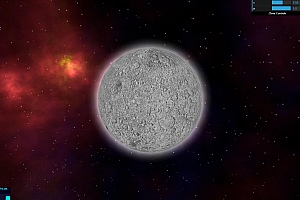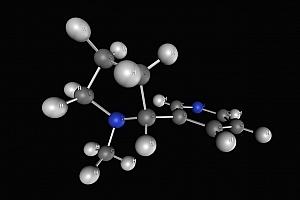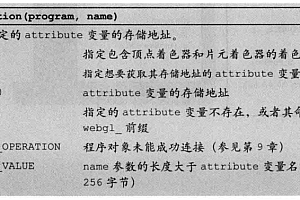WebGL基础入门教程(六):第一个三维示例(使用模型视图投影变换)
1. 概述
在上一篇教程《WebGL简易教程(五):图形变换(模型、视图、投影变换)》中,详细讲解了OpenGL/WebGL关于绘制场景的模型变换、视图变换以及投影变换的过程。不过那篇教程是纯理论知识,这里就具体结合一个实际的例子,进一步理解WebGL中是如何通过图形变换让一个真正的三维场景显示出来。
2. 示例:绘制多个三角形
继续改进之前的代码,这次就更进一步,在一个场景中绘制了三个三角形。
2.1. Triangle_MVPMatrix.html
<!DOCTYPE html>
<html lang="en">
<head>
<meta charset="utf-8" />
<title>Hello Triangle</title>
</head>
<body onload="main()">
<canvas id="webgl" width="400" height="400">
Please use a browser that supports "canvas"
</canvas>
<script src="../lib/webgl-utils.js"></script>
<script src="../lib/webgl-debug.js"></script>
<script src="../lib/cuon-utils.js"></script>
<script src="../lib/cuon-matrix.js"></script>
<script src="Triangle_MVPMatrix.js"></script>
</body>
</html>
与之间的代码相比,这段代码主要是引入了一个cuon-matrix.js,这个是一个图形矩阵的处理库,能够方便与GLSL进行交互。
2.2. Triangle_MVPMatrix.js
// 顶点着色器程序
var VSHADER_SOURCE =
'attribute vec4 a_Position;/n' + // attribute variable
'attribute vec4 a_Color;/n' +
'uniform mat4 u_MvpMatrix;/n' +
'varying vec4 v_Color;/n' +
'void main() {/n' +
' gl_Position = u_MvpMatrix * a_Position;/n' + // Set the vertex coordinates of the point
' v_Color = a_Color;/n' +
'}/n';
// 片元着色器程序
var FSHADER_SOURCE =
'precision mediump float;/n' +
'varying vec4 v_Color;/n' +
'void main() {/n' +
' gl_FragColor = v_Color;/n' +
'}/n';
function main() {
// 获取 <canvas> 元素
var canvas = document.getElementById('webgl');
// 获取WebGL渲染上下文
var gl = getWebGLContext(canvas);
if (!gl) {
console.log('Failed to get the rendering context for WebGL');
return;
}
// 初始化着色器
if (!initShaders(gl, VSHADER_SOURCE, FSHADER_SOURCE)) {
console.log('Failed to intialize shaders.');
return;
}
// 设置顶点位置
var n = initVertexBuffers(gl);
if (n < 0) {
console.log('Failed to set the positions of the vertices');
return;
}
//设置MVP矩阵
setMVPMatrix(gl,canvas);
// 指定清空<canvas>的颜色
gl.clearColor(0.0, 0.0, 0.0, 1.0);
// 开启深度测试
gl.enable(gl.DEPTH_TEST);
// 清空颜色和深度缓冲区
gl.clear(gl.COLOR_BUFFER_BIT | gl.DEPTH_BUFFER_BIT);
// 绘制三角形
gl.drawArrays(gl.TRIANGLES, 0, n);
}
//设置MVP矩阵
function setMVPMatrix(gl,canvas) {
// Get the storage location of u_MvpMatrix
var u_MvpMatrix = gl.getUniformLocation(gl.program, 'u_MvpMatrix');
if (!u_MvpMatrix) {
console.log('Failed to get the storage location of u_MvpMatrix');
return;
}
//模型矩阵
var modelMatrix = new Matrix4();
modelMatrix.setTranslate(0.75, 0, 0);
//视图矩阵
var viewMatrix = new Matrix4(); // View matrix
viewMatrix.setLookAt(0, 0, 5, 0, 0, -100, 0, 1, 0);
//投影矩阵
var projMatrix = new Matrix4(); // Projection matrix
projMatrix.setPerspective(30, canvas.width / canvas.height, 1, 100);
//MVP矩阵
var mvpMatrix = new Matrix4();
mvpMatrix.set(projMatrix).multiply(viewMatrix).multiply(modelMatrix);
//将MVP矩阵传输到着色器的uniform变量u_MvpMatrix
gl.uniformMatrix4fv(u_MvpMatrix, false, mvpMatrix.elements);
}
//
function initVertexBuffers(gl) {
// 顶点坐标和颜色
var verticesColors = new Float32Array([
0.0, 1.0, -4.0, 0.4, 1.0, 0.4, //绿色在后
-0.5, -1.0, -4.0, 0.4, 1.0, 0.4,
0.5, -1.0, -4.0, 1.0, 0.4, 0.4,
0.0, 1.0, -2.0, 1.0, 1.0, 0.4, //黄色在中
-0.5, -1.0, -2.0, 1.0, 1.0, 0.4,
0.5, -1.0, -2.0, 1.0, 0.4, 0.4,
0.0, 1.0, 0.0, 0.4, 0.4, 1.0, //蓝色在前
-0.5, -1.0, 0.0, 0.4, 0.4, 1.0,
0.5, -1.0, 0.0, 1.0, 0.4, 0.4,
]);
//
var n = 9; // 点的个数
var FSIZE = verticesColors.BYTES_PER_ELEMENT; //数组中每个元素的字节数
// 创建缓冲区对象
var vertexBuffer = gl.createBuffer();
if (!vertexBuffer) {
console.log('Failed to create the buffer object');
return -1;
}
// 将缓冲区对象绑定到目标
gl.bindBuffer(gl.ARRAY_BUFFER, vertexBuffer);
// 向缓冲区对象写入数据
gl.bufferData(gl.ARRAY_BUFFER, verticesColors, gl.STATIC_DRAW);
//获取着色器中attribute变量a_Position的地址
var a_Position = gl.getAttribLocation(gl.program, 'a_Position');
if (a_Position < 0) {
console.log('Failed to get the storage location of a_Position');
return -1;
}
// 将缓冲区对象分配给a_Position变量
gl.vertexAttribPointer(a_Position, 3, gl.FLOAT, false, FSIZE * 6, 0);
// 连接a_Position变量与分配给它的缓冲区对象
gl.enableVertexAttribArray(a_Position);
//获取着色器中attribute变量a_Color的地址
var a_Color = gl.getAttribLocation(gl.program, 'a_Color');
if (a_Color < 0) {
console.log('Failed to get the storage location of a_Color');
return -1;
}
// 将缓冲区对象分配给a_Color变量
gl.vertexAttribPointer(a_Color, 3, gl.FLOAT, false, FSIZE * 6, FSIZE * 3);
// 连接a_Color变量与分配给它的缓冲区对象
gl.enableVertexAttribArray(a_Color);
// 解除绑定
gl.bindBuffer(gl.ARRAY_BUFFER, null);
return n;
}
相比之前的代码,主要做了3点改进:
- 数据加入Z值;
- 加入了深度测试;
- MVP矩阵设置;
2.2.1. 数据加入Z值
之前绘制的三角形,只有X坐标和Y坐标,Z值坐标自动补足为默认为0的。在这里会绘制了3个三角形,每个三角形的深度不同。如下代码所示,定义了3个三角形9个点,每个点包含xyz信息和rgb信息:
// 顶点坐标和颜色
var verticesColors = new Float32Array([
0.0, 1.0, -4.0, 0.4, 1.0, 0.4, //绿色在后
-0.5, -1.0, -4.0, 0.4, 1.0, 0.4,
0.5, -1.0, -4.0, 1.0, 0.4, 0.4,
0.0, 1.0, -2.0, 1.0, 1.0, 0.4, //黄色在中
-0.5, -1.0, -2.0, 1.0, 1.0, 0.4,
0.5, -1.0, -2.0, 1.0, 0.4, 0.4,
0.0, 1.0, 0.0, 0.4, 0.4, 1.0, //蓝色在前
-0.5, -1.0, 0.0, 0.4, 0.4, 1.0,
0.5, -1.0, 0.0, 1.0, 0.4, 0.4,
]);
这意味着与着色器传输变量的函数gl.vertexAttribPointer()的参数也得相应的变化。注意要深入理解这个函数每个参数代表的含义:
// ...
// 将缓冲区对象分配给a_Position变量
gl.vertexAttribPointer(a_Position, 3, gl.FLOAT, false, FSIZE * 6, 0);
// ...
// 将缓冲区对象分配给a_Color变量
gl.vertexAttribPointer(a_Color, 3, gl.FLOAT, false, FSIZE * 6, FSIZE * 3);
2.2.2. 加入深度测试
在默认情况下,WebGL是根据顶点在缓冲区的顺序来进行绘制的,后绘制的图形会覆盖已经绘制好的图形。但是这样往往与实际物体遮挡情况不同,造成一些很怪异的现象,比如远的物体反而遮挡了近的物体。所以WebGL提供了一种深度检测(DEPTH_TEST)的功能,启用该功能就会检测物体(实际是每个像素)的深度,来决定是否绘制。其启用函数为:

除此之外,还应该注意在绘制每一帧之前都应该清除深度缓冲区(depth buffer)。WebGL有多种缓冲区。我们之前用到的与顶点着色器交互的缓冲区对象就是顶点缓冲区,每次重新绘制刷新的就是颜色缓冲区。深度缓冲区记录的就是每个几何图形的深度信息,每绘制一帧,都应清除深度缓冲区:

在本例中的相关代码为:
// ...
// 开启深度测试
gl.enable(gl.DEPTH_TEST);
// 清空颜色和深度缓冲区
gl.clear(gl.COLOR_BUFF
ER_BIT | gl.DEPTH_BUFFER_BIT);
// ...
2.2.3. MVP矩阵设置
在上一篇教程中提到过,WebGL的任何图形变换过程影响的都是物体的顶点,模型变换、视图变换、投影变换都是在顶点着色器中实现的。由于每个顶点都是要进行模型视图投影变换的,所以可以合并成一个MVP矩阵,将其传入到顶点着色器中的:
//...
'uniform mat4 u_MvpMatrix;/n' +
'void main() {/n' +
' gl_Position = u_MvpMatrix * a_Position;/n' + // Set the vertex coordinates of the point
//...
'}/n';
在函数setMVPMatrix()中,创建了MVP矩阵,并将其传入到着色器:
//设置MVP矩阵
function setMVPMatrix(gl,canvas) {
// Get the storage location of u_MvpMatrix
var u_MvpMatrix = gl.getUniformLocation(gl.program, 'u_MvpMatrix');
if (!u_MvpMatrix) {
console.log('Failed to get the storage location of u_MvpMatrix');
return;
}
//模型矩阵
var modelMatrix = new Matrix4();
modelMatrix.setTranslate(0.75, 0, 0);
//视图矩阵
var viewMatrix = new Matrix4(); // View matrix
viewMatrix.setLookAt(0, 0, 5, 0, 0, -100, 0, 1, 0);
//投影矩阵
var projMatrix = new Matrix4(); // Projection matrix
projMatrix.setPerspective(30, canvas.width / canvas.height, 1, 100);
//MVP矩阵
var mvpMatrix = new Matrix4();
mvpMatrix.set(projMatrix).multiply(viewMatrix).multiply(modelMatrix);
//将MVP矩阵传输到着色器的uniform变量u_MvpMatrix
gl.uniformMatrix4fv(u_MvpMatrix, false, mvpMatrix.elements);
}
在上述代码中,依次分别设置了:
- 模型矩阵:X方向上平移了0.75个单位。
- 视图矩阵:视点为(0,0,5),观察点为(0,0,-100),上方向为(0,1,0)的观察视角。
- 投影矩阵:垂直张角为30,画图视图的宽高比,近截面距离为1,远截面为100的视锥体。
三者级联,得到MVP矩阵,将其传入到顶点着色器中。
3. 结果
用浏览器打开Triangle_MVPMatrix.html,就会发现浏览器页面显示了一个由远及近,近大远小的三个三角形。如图所示:

4. 参考
本来部分代码和插图来自《WebGL编程指南》。
WEBGL学习网 » WebGL基础入门教程(六):第一个三维示例(使用模型视图投影变换)









